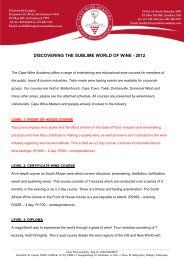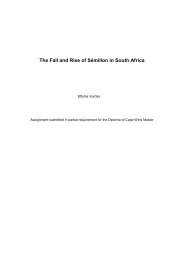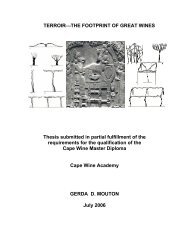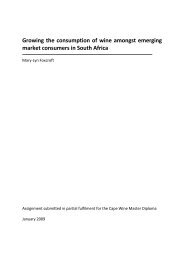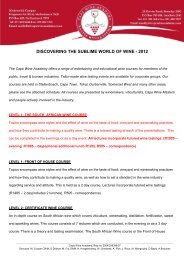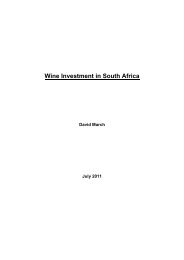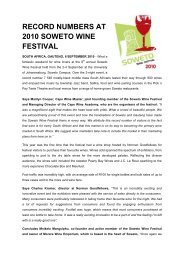micro-oxygenation in contemporary winemaking - Cape Wine ...
micro-oxygenation in contemporary winemaking - Cape Wine ...
micro-oxygenation in contemporary winemaking - Cape Wine ...
Create successful ePaper yourself
Turn your PDF publications into a flip-book with our unique Google optimized e-Paper software.
Micro-<strong>oxygenation</strong> <strong>in</strong> Contemporary W<strong>in</strong>emak<strong>in</strong>gAccurate recent figures on worldwide sales of <strong>micro</strong>-<strong>oxygenation</strong> equipment are notavailable. France rema<strong>in</strong>s the largest user of <strong>micro</strong>-<strong>oxygenation</strong> with over 2000 units <strong>in</strong>operation by 2006, ma<strong>in</strong>ly <strong>in</strong> Bordeaux (Rob<strong>in</strong>son, 2006). A similar number of units havebeen sold worldwide. Uptake has been significant <strong>in</strong> Italy (Dempsey, 2001), Chile (Goode,2005; Rob<strong>in</strong>son, 2006) and the United States (Zoeckle<strong>in</strong> et al., 2002). For example, <strong>in</strong> a2007 survey of American w<strong>in</strong>eries, 16% of small w<strong>in</strong>eries, 50% of medium-sized w<strong>in</strong>eries,and 83% of large w<strong>in</strong>eries admitted to us<strong>in</strong>g <strong>micro</strong>-<strong>oxygenation</strong> on some of their w<strong>in</strong>es(Goldfarb, 2007). Internationally, some of the most high profile producers publiclypromot<strong>in</strong>g <strong>micro</strong>-<strong>oxygenation</strong> <strong>in</strong>clude Randall Graham of Bonny Doon (Graham, 2003),E&J Gallo (Rieger, 2000), Doma<strong>in</strong>e Chandon (Dempsey, 2001), and Vasse Felix (Otto,2003). The market <strong>in</strong> South African is still relatively small but the technique has been usedby a number of producers and local sales of the equipment cont<strong>in</strong>ue to <strong>in</strong>crease(Euroberry, 2008a).Phenolic chemistry is a very important and rich area of w<strong>in</strong>e research. The fundamentalreactions which seem to be implicated <strong>in</strong> <strong>micro</strong>-<strong>oxygenation</strong> were well known by the timethe technique was actually developed (Rieger, 2000).Vernon S<strong>in</strong>gleton and his associates at UC Davis <strong>in</strong> California elucidated the keymechanisms <strong>in</strong>volved <strong>in</strong> the oxidation of phenolic compounds <strong>in</strong> musts and w<strong>in</strong>es <strong>in</strong> the1970s and 80s (S<strong>in</strong>gleton, 1987). The fact that colour stability <strong>in</strong> w<strong>in</strong>e was due toanthocyan<strong>in</strong>s react<strong>in</strong>g with other compounds to produce large polymeric pigments was firstidentified by Pascal Ribéreau-Gayon and Emile Peynaud <strong>in</strong> 1962 [cited <strong>in</strong> (Thorngate andS<strong>in</strong>gleton, 1994)]. The work detail<strong>in</strong>g these reactions between anthocyan<strong>in</strong>s and tann<strong>in</strong>molecules was ma<strong>in</strong>ly completed by Somers <strong>in</strong> the rema<strong>in</strong><strong>in</strong>g years of that decade(Somers, 1971). Another very important part of the puzzle was research <strong>in</strong> the early 1970sthat demonstrated that acetaldehyde (produced from the oxidation of ethanol) was the l<strong>in</strong>k<strong>in</strong> certa<strong>in</strong> condensation reactions between anthocyan<strong>in</strong> and tann<strong>in</strong>s (Wildenradt andS<strong>in</strong>gleton, 1974; Timberlake and Bridle, 1976).Of the more recent discoveries which may be of some relevance to the chemistry of <strong>micro</strong><strong>oxygenation</strong>are the discovery of the category of compounds known aspyranoanthocyan<strong>in</strong>s (Fulcrand et al., 1996; Monagas et al., 2005; Fulcrand et al., 2006),and research on the central role of iron and copper <strong>in</strong> the oxidation reactions of phenols <strong>in</strong>w<strong>in</strong>e (Danilewicz, 2003; Danilewicz, 2007).8



